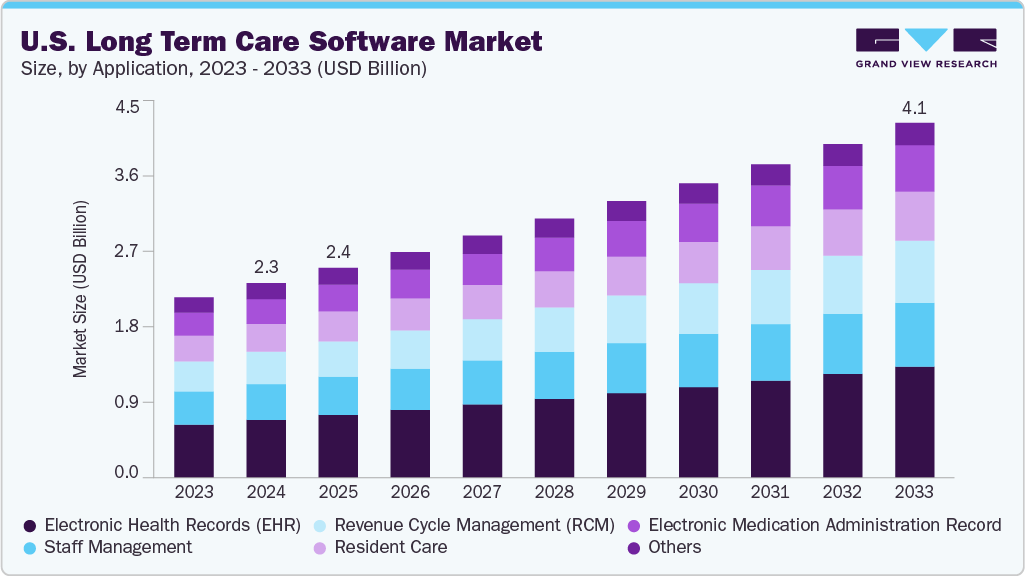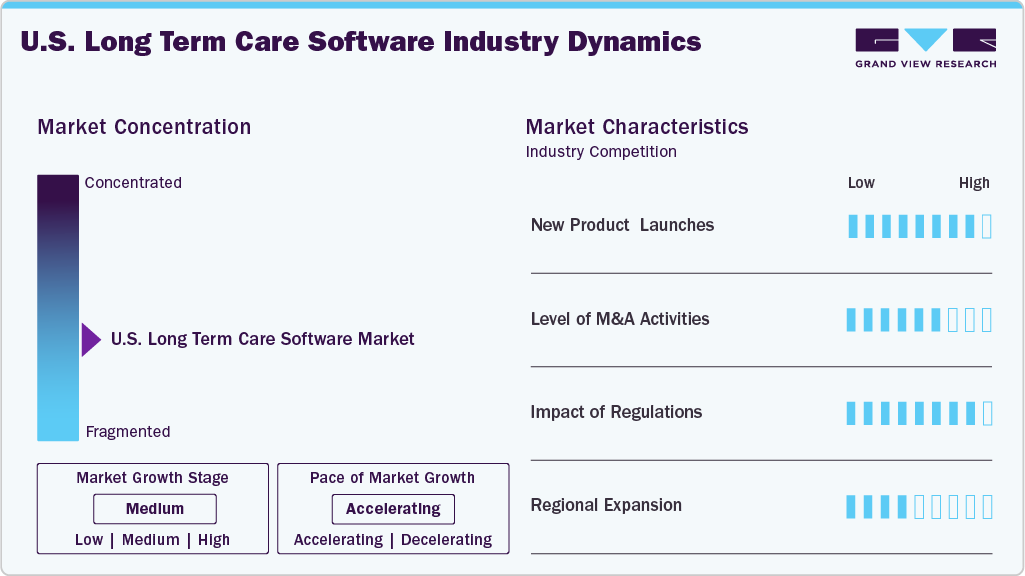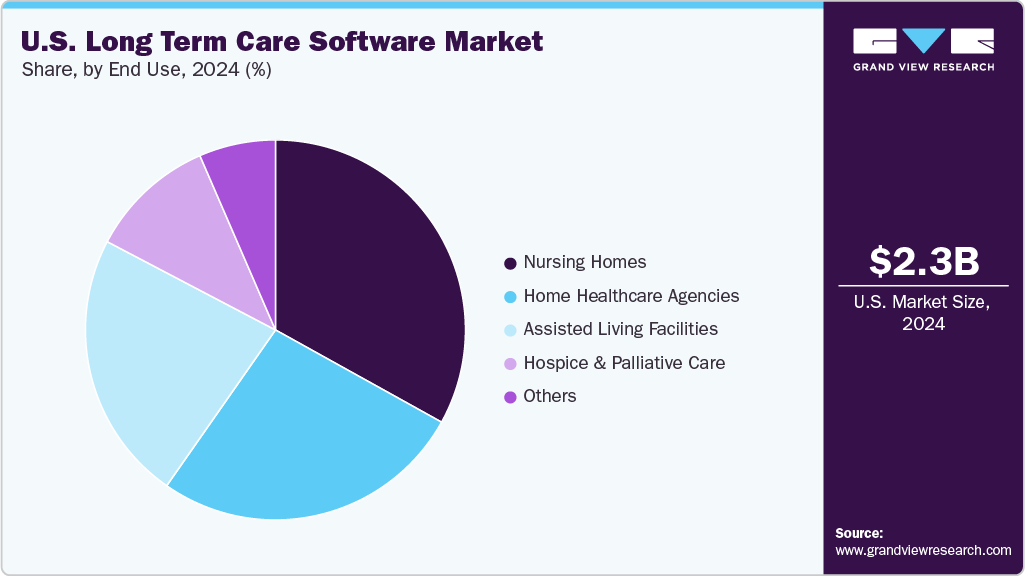- Home
- »
- Healthcare IT
- »
-
U.S. Long Term Care Software Market, Industry Report, 2033GVR Report cover
![U.S. Long Term Care Software Market Size, Share & Trends Report]()
U.S. Long Term Care Software Market (2025 - 2033) Size, Share & Trends Analysis Report By Mode Of Delivery (Cloud-based, Web-based, On-premises), By Application (Electronic Health Records (EHR), Revenue Cycle Management (RCM)), By End Use, And Segment Forecasts
- Report ID: GVR-4-68040-035-9
- Number of Report Pages: 100
- Format: PDF
- Historical Range: 2021 - 2024
- Forecast Period: 2025 - 2033
- Industry: Healthcare
- Report Summary
- Table of Contents
- Segmentation
- Methodology
- Download FREE Sample
-
Download Sample Report
U.S. Long Term Care Software Market Summary
The U.S. long term care software market size was estimated at USD 2.25 billion in 2024 and is projected to reach USD 4.11 billion by 2033, growing at a CAGR of 6.79% from 2025 to 2033. Long-term care (LTC) is becoming increasingly significant in the United States, which is primarily attributed to the rising healthcare requirements of the rapidly aging population.
Key Market Trends & Insights
- Based on mode of delivery, the cloud-based segment held the largest market share of 41.39% in 2024.
- Based on applications, the electronic health records (EHR) segment held the largest market share in 2024.
- By end use, the nursing homes segment held the highest market share in 2024.
Market Size & Forecast
- 2024 Market Size: USD 2.25 billion
- 2033 Projected Market Size: USD 4.11 billion
- CAGR (2025-2033): 6.79%
LTC software assists individuals with their medical and personal care, empowering them to maintain independent living. The growing adoption of electronic health records (EHR) and the increased usage of LTC centers are key factors driving market expansion. In addition, the increasing prevalence of chronic diseases and a growing geriatric population contribute to market growth.LTC offers time and cost-saving workflow techniques, including a centralized database, integrated Electronic Health Records (EHRs), and solutions for medication management, payroll management, resident care, revenue cycle management, clinical documentation, and more. These features enable effective patient care, improved compliance, and cost reduction.

The shortage of nursing staff and increasing burnout among healthcare professionals in the U.S. have driven the adoption of healthcare IT solutions in recent years. This shortage-driven by an aging population, rising patient volumes, and clinician burnout-is creating widespread pressure on healthcare facilities to manage limited staff resources better while maintaining care quality and compliance. For instance, according to the data cited by the American Association of Colleges of Nursing (AACN), federal authorities projected a shortage of 78,610 full-time registered nurses (RNs) in 2025 and 63,720 in 2030.
Thus, many LTC providers are incorporating these tools to streamline their workflow. For instance, in October 2022, the American Health Care Association (AHCA) announced that PointClickCare had joined the Long-Term Care Data Cooperative, working together to develop a comprehensive health records solution.
Moreover, the U.S. long-term care software market is expected to grow significantly due to the increasing geriatric population in the country. As the elderly population aged 65 and older continues to grow and live longer, there is a rising demand for long-term care services and software to address their needs effectively. According to data from the Population Reference Bureau, the number of Americans aged 65 years and above is projected to reach 82 million by 2050 from 58 million in 2022, resulting in a higher percentage of older adults, from 17% to 23%.
Furthermore, long-term care providers are undertaking strategic initiatives to prioritize quality care. For instance, in February 2022, Creative Solutions in Healthcare (CSNHC) unveiled its innovative software platform, Connected Care Center. This platform increases transparency among its 92 skilled nursing facilities by facilitating the seamless & private sharing of vital patient information, such as medical diagnoses, vital signs, and medical orders. By adopting such technology, long-term care facilities optimize operations and ensure more efficient patient-centric care. As healthcare providers continue to focus on improving quality & efficiency, the U.S. long-term care software market is poised for significant expansion, positively impacting the healthcare ecosystem.
Market Concentration & Characteristics
The chart below illustrates the relationship between industry concentration, industry characteristics, and industry participants. The x-axis represents the level of industry concentration, ranging from low to high. The y-axis represents various industry characteristics, including industry competition, level of partnerships & collaboration activities, degree of innovation, impact of regulations, and regional expansion. The U.S. long term care software industry is fragmented, with the presence of several software and solution providers dominating the market. The degree of innovation and impact of regulations on the industry is high. Moreover, the level of merger & acquisition activities and the regional expansion of industry is moderate.
The U.S. long term care software industry experiences a high degree of innovation driven by technological advancements. Market players are launching new products to enhance their market presence. For instance, in March 2025, ECP launched a Senior Living Integration Hub and Developer Portal, enabling seamless connectivity between ECP’s software and other solutions used by senior living operators. The portal offers API specs and code samples and supports bidirectional integrations, enhancing data flow, reducing manual entry, and supporting over 7,500 communities nationwide.

“ECP has been integrating with other senior living technology providers for two decades, and we are thrilled to formally launch ECP’s Integration Hub and Developer Portal to make it easier than ever for customers and other technology providers to partner with ECP.”
-Adam Aisen, CEO of ECP.
The market is also characterized by a moderate level of merger and acquisition (M&A) activity by the leading players. This is due to the desire to gain a competitive advantage in the industry, enhance technological capabilities, and consolidate in a rapidly growing market. Moreover, increasing merger and acquisition activities by long-term care providers also impact market growth. For instance, in December 2023, Creative Solutions in Healthcare acquired 12 facilities, including 11 skilled nursing facilities and one assisted living facility.
The regulatory framework for the U.S. long-term care software market is primarily shaped by updates and compliance requirements from the Centers for Medicare & Medicaid Services (CMS). Recent updates emphasize data exchange via FHIR APIs, automated prior authorizations, and robust reporting for infection control. Compliance with enhanced quality standards and privacy safeguards is mandatory to ensure safe, efficient care delivery.
The market experiences moderate regional expansion. Software providers are partnering with care providers, thereby establishing a strong foothold in the market. For instance, in January 2024, MatrixCare formed a strategic partnership with Tranzion, a National HealthCare Corporation (NHC) subsidiary, to expand Electronic Health Record (EHR) services for senior living and long-term care providers. MatrixCare is likely to provide advanced EHR technology, including artificial intelligence (AI) and machine learning, to enhance patient care, streamline operations, and improve clinical outcomes across Tranzion’s network.
Mode of Delivery Insights
Based on delivery mode, the cloud-based segment accounted for the largest revenue share of 41.39% in 2024. In addition, it is projected to experience growth at the fastest CAGR during the forecast period. Cloud-based solutions offer cost-effectiveness, flexible cost & usage options, fewer operational issues, low initial investment, and enhanced security. Moreover, the demand for cloud-based solutions is rising, leading to the development of new products.
For instance, in September 2022, RedSail Technologies and Guardian Pharmacy of Indianapolis collaborated to launch Axys by Integra, an LTC pharmacy software tailored to modern technology and the specific needs of LTC pharmacies. Such developments are transforming the market for long-term Care software, improving efficiency and care delivery.
The web-based segment is expected to witness substantial growth, driven by the increasing usage of online platforms. On the other hand, on-premises solutions, which are installed at user locations, primarily on workstations, are likely to face challenges due to their high initial costs, thereby affecting their market growth. As technology evolves, more clinics are expected to opt for cloud-based solutions, which offer cost-effectiveness, flexibility, and enhanced accessibility.
Application Insights
In terms of application, the electronic health records (EHR) segment accounted for the largest revenue share of 29.74% in 2024 due to the rising need for centralized and interoperable patient data management. In addition, this segment is anticipated to grow at the fastest CAGR from 2025 to 2033. Long-term care facilities require systems that can consolidate medical histories, care plans, and treatment progress for elderly and chronically ill patients.
The expansion of the EHR segment is also supported by advancements in cloud-based solutions, AI-enabled analytics, and mobile accessibility, which make implementation more cost-effective and user-friendly. Moreover, the ability of modern EHRs to link with telehealth platforms, medication management systems, and billing solutions enhances workflow efficiency.
The revenue cycle management segment is expected to witness a significant growth rate during the forecast period. Providers face challenges in managing claims, reducing denials, and ensuring timely reimbursements from Medicare, Medicaid, and private insurers. RCM solutions streamline these processes by automating coding, claims submission, and payment tracking, reducing administrative burdens. As reimbursement models shift toward value-based care, demand for advanced RCM tools continues to expand.
End Use Insights
On the basis of end use, the nursing homes segment dominated the market with a share of 33.07% in 2024. Increasing awareness about nursing care services, rising EHR implementation in skilled nursing facilities (SNFs), and high patient safety are key factors contributing to the growth of the segment. Based on end use, the market is segmented into home healthcare agencies, hospice & palliative care, nursing homes, assisted living facilities, and others.

As the demand for nursing homes continues to rise with the aging population, LTC software solutions are expected to support streamlining operations, improve care coordination, and enhance resident experiences. The adoption of such software is anticipated to drive the growth of the nursing home segment, facilitating efficient and comprehensive care for elderly individuals in need.
The home healthcare agencies segment is projected to exhibit growth at the fastest CAGR during the forecast period. Increasing preference for care at home among the elderly and the rising number of remote monitoring solutions enabling independent living are driving high growth of the segment. The segment is likely to further benefit from technological advancements such as telemedicine, mHealth apps, and internet-enabled home monitoring.
Key U.S. Long Term Care Software Company Insights
The U.S. market landscape is fragmented, with the presence of a small number of companies holding a majority stake. New expansion activities, product approvals, product launches, partnerships, and acquisitions have positively impacted the U.S. industry in recent years. Furthermore, there has been a significant increase in the demand for long term care software due to the growing digitalization, which in turn is fueling market growth.
Key U.S. Long Term Care Software Companies:
- Veradigm LLC
- Oracle
- Netsmart Technologies, Inc.
- MatrixCare
- Yardi Systems, Inc.
- VITALS SOFTWARE
- PointClickCare
- Medtelligent, Inc.
- AL Advantage, LLC
- Genexod Technologies LLC
- Revver, Inc.
Recent Developments
-
In March 2024, Creative Solutions in Healthcare acquired five skilled nursing facilities from Diversicare, expanding its Texas portfolio to 174 properties, including 153 skilled nursing centers.
-
In February 2024, Creative Solutions in Healthcare expanded its presence in El Paso, Texas, by acquiring two skilled nursing facilities: El Paso Health & Rehab and Vista Hills Health Care Center.
-
In June 2023, Netsmart and nVoq partnered to enable integrated voice recognition in order to help in-home healthcare clients with their documentation problems.
-
In March 2023, VITAS Healthcare, a provider of end-of-life care, partnered with WellSky to leverage WellSky’s electronic health record (EHR) technology to streamline operations and enhance clinical workflows. The organizations are anticipated to collaborate to advance innovations in hospice and palliative care technology, supporting VITAS in expanding into new markets.
U.S. Long Term Care Software Market Report Scope
Report Attribute
Details
Market size value in 2025
USD 2.42 billion
Revenue Forecast in 2033
USD 4.11 billion
Growth rate
CAGR of 6.79% from 2025 to 2033
Actual data
2021 - 2024
Forecast period
2025 - 2033
Quantitative units
Revenue in USD million/billion and CAGR from 2025 to 2033
Report coverage
Revenue forecast, company ranking, competitive landscape, growth factors, and trends
Segments covered
Mode of delivery, application, end use
Country scope
U.S.
Key companies profiled
Veradigm LLC; Oracle; Netsmart Technologies, Inc.; MatrixCare; Yardi Systems, Inc.; VITALS SOFTWARE; PointClickCare; Medtelligent, Inc.; AL Advantage, LLC; Genexod Technologies LLC; Revver, Inc.
Customization scope
Free report customization (equivalent up to 8 analyst’s working days) with purchase. Addition or alteration to country, regional & segment scope.
Pricing and purchase options
Avail customized purchase options to meet your exact research needs. Explore purchase options
U.S. Long Term Care Software Market Report Segmentation
This report forecasts revenue growth at the country level and provides an analysis of the latest industry trends in each of the sub-segments from 2021 to 2033. For this study, Grand View Research has segmented the U.S. long term care software market report based on mode of delivery, application, and end use:
-
Mode of Delivery Outlook (Revenue, USD Million, 2021 - 2033)
-
Cloud based
-
Web based
-
On premise
-
-
Application Outlook (Revenue, USD Million, 2021 - 2033)
-
Electronic Health Records (EHR)
-
Electronic Medication Administration Record (eMAR)
-
Revenue Cycle Management (RCM)
-
Resident Care
-
Staff Management
-
Others
-
-
End Use Outlook (Revenue, USD Million, 2021 - 2033)
-
Home Healthcare Agencies
-
Hospice & Palliative care
-
Nursing Homes
-
Assisted living facilities
-
Others
-
Frequently Asked Questions About This Report
b. The U.S. long term care software market size was estimated at USD 2.25 billion in 2024 and is expected to reach USD 2.43 billion in 2025.
b. The U.S. long term care software market is expected to grow at a compound annual growth rate of 6.79% from 2025 to 2033 to reach USD 4.11 billion by 2033.
b. The EHR segment dominated the U.S. long term care software with a share of 29.74% in 2024. The growth of segment is attributed due to increased government initiative for the implementation of EHR in healthcare facilities.
b. Some key players operating in the U.S. long term care software include Veradigm LLC Oracle Netsmart Technologies, Inc. MatrixCare; Yardi Systems, Inc. VITALS SOFTWARE PointClickCare; Medtelligent, Inc.; AL Advantage, LLC Genexod Technologies LLC; Revver, Inc.
b. Key factors that are driving the market growth include the increasing geriatric population, growing prevalence of chronic diseases, and rising government efforts to boost healthcare software adoption in the healthcare system.
Share this report with your colleague or friend.
Need a Tailored Report?
Customize this report to your needs — add regions, segments, or data points, with 20% free customization.

ISO 9001:2015 & 27001:2022 Certified
We are GDPR and CCPA compliant! Your transaction & personal information is safe and secure. For more details, please read our privacy policy.
Trusted market insights - try a free sample
See how our reports are structured and why industry leaders rely on Grand View Research. Get a free sample or ask us to tailor this report to your needs.










